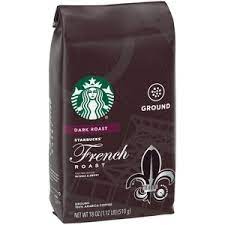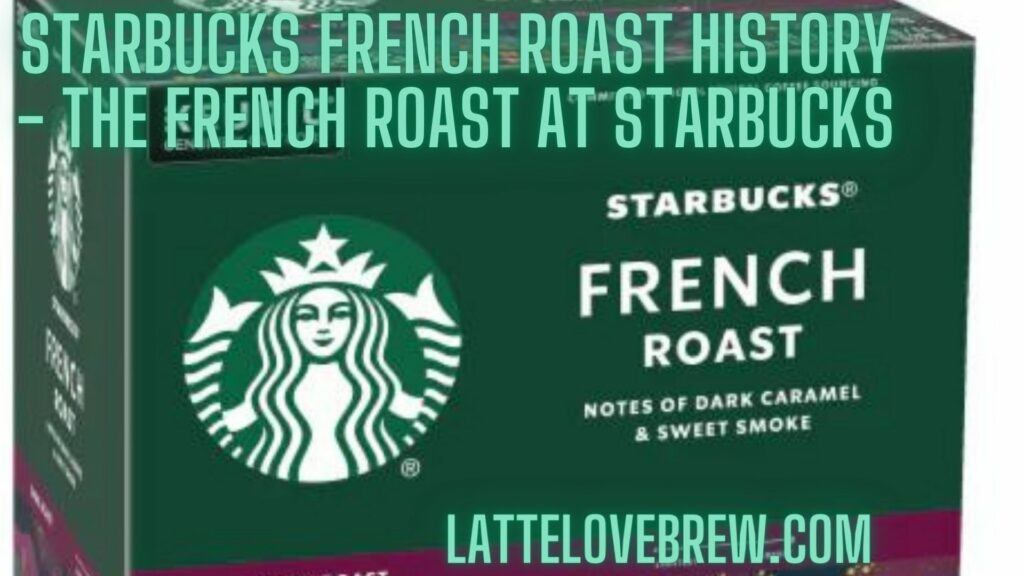Last updated on January 22nd, 2024 at 13:24
On our online coffee community I got asked a question about Starbucks French roast history. This article does that, details French roast and little history of it at Starbucks and what you can expect their French roast to taste like.
It tastes very different from their standard Pike Place.
Keep reading to find out about this, deep and dark roasted coffee.
Starbucks French Roast History – What Is A French Roast?
Table Of Contents
- 1 Starbucks French Roast History – What Is A French Roast?
- 2 What Does Starbucks French Roast Taste Like?
- 3 French Roast History – A Geographical Trip!
- 4 How Is A French Roast Different From Other Roasts?
- 5 A French Roast Is Also Known As A Turkish Roast
- 6 Frequently Asked Questions About Starbucks French Roast History
- 7 Final Thoughts – Starbucks French Roast History
A French roast is the second darkest of the 4 dark roast coffee beans. They are roasted at 240C (464F) to produce a cup of coffee that is richer in flavor, with a deep, dark and very robust traditional coffee taste with notes of smokiness caused by the burning oils and sugars, an almost charred taste.
If you are a hardcore coffee lover or an experimental coffee fan I suggest you try a deep dark roast like a French or Italian roast. If you enjoy espresso shots or a ristretto, I think you will love these darker roasts.
The history of Starbucks and their French roast dates to 1971 and has been a popular choice since then due to it being low in acidity and intense taste.
At the time of its introduction, it was the darkest roast available at the coffee conglomerate. The darkest roast that is now available at Starbucks is now an Italian roast.
The only thing that changes with Starbucks and their roasts is the packaging and the way in which their products are available, instant, preground, whole beans and single serve coffee pods. I expect that if a new popular form or brewing process of enjoying coffee develops, they will make their coffee available for the new type of machine or process.

Read: What does French roast mean?
What Does Starbucks French Roast Taste Like?
Freshly roasted French roast ground coffee has an earthy and dark aroma, more so when the whole beans are freshly ground, which is a nice prelude to the roasty brew that this coffee produces.
The roasty notes and roasted flavors exude caramelized smoky tones that are the very character of this Starbucks coffee.
Looking into your mug you will notice the very dark color and mild sheen of the oils. Starbucks French roast coffee is tasty, delicious where the earthy tones and dark caramel hints border on (but are not) burnt flavor.
The aftertaste is only mildly astringent with deep roasty tones that linger in your mouth; this Starbucks coffee is definitely one for those that enjoy roasted aroma, tones and flavors.
If you are a lighter roast coffee drinker, a splash of milk or cream and a little sugar may help to tone it down to your liking.
Why Is It Called A French Roast?
A French roast is so called due to the roasting process of using an elevated temperature being used a lot in France in the 1800s and the way that the French loved their coffee, strong, bold and with deep, dark aromas.
The roast profile was first named in the United States shortly after they started to replicate the way the French enjoyed their coffee. Due to the high level of roasting, it does not need high quality coffee beans to be taken to a French roast profile.
French Roast History – A Geographical Trip!
In the 1800s, the 19th Century, Europeans loved their coffee to be, bold, dark and an aromatic. Austrians have their roast, the Vienna roast, which is roasted at lower temperature and has a slightly lighter color and produces a different tasting cup of coffee.
Italians, have their own roast, an Italian roast, which is roasted at a slightly higher temperature than a French roast and is darker and bolder in flavor.
The French, enjoy their coffee somewhere in between the other two nations, and produce a roasted coffee that is darker than a Vienna roast and lighter than an Italian getting some of the flavor benefits of both.
And that is how French roast coffee beans came around, a lovely roast that is a step up from a Vienna roast yet a step-down from a very darkly roasted Italian roast.
| Roast Profile | Roasting Temperature | Characteristics Of The Roast |
| Vienna | 230C (446F) | A moderate dark brown color and has light surface oil, caramel notes and bittersweet tones with a muted acidity. |
| French | 240C (464F) | Dark brown in color and has a shiny coating of oil. A reduced acidity and deep caramel tones. Smoky aroma. |
| Italian | 245C (473F) | Almost completely black in color and with burnt tones with a thin body and almost no acidity. Very deep, bold and smoky. |
Read: What is French roast coffee?
How Is A French Roast Different From Other Roasts?
There are 10 different roast levels and all types of coffee beans can be taken to any roast level. The question arises, how is a French roast different from the other roasts?
Here are a few key points that make this level of roasting different from others:
- French roast has a strong bold flavor while not having a completely burnt ash like taste.
- The bean is dark, very dark but not completely black. The color stands out from other dark roasts.
- It has a reduced acidity when compared to other roasts (except an Italian roast). Both a French and an Italian roast have lower PH levels.
- They have a shiny coat of oil on the surface. Coffees roasted to a high roasting profile the oils start to migrate to the exterior of the bean.
A French Roast Is Also Known As A Turkish Roast
When you order a dark roast at a western coffee shop you will get served a French roast. Head out to Eastern Europe and to the “bridge” nation that links Europe with Asia, you will notice that the name French is replaced with Turkish for the same roast.
These foreign coffee shops use the same roast, brew quite a fantastic traditional coffee, honestly a Turkish coffee, has to be enjoyed.
While walking around Istanbul looking at various bags of coffee, I noticed the phrase “dark French roast” which is quite peculiar as they call the original French roast a Turkish roast and is only a shade darker and not quite an Italian roast.
Why they don’t use the name dark Turkish roast I have no idea – your guess is as good as mine! It is an oddity.
Frequently Asked Questions About Starbucks French Roast History
Where Does Starbucks French Roast Come From?
Starbucks Organic French roast ground coffee or whole beans is a made from 100% Arabica beans which are sourced from Latin America and Asia Pacific. Due to trademark reasons Starbucks are not revealing the exact countries or regions within the nations.
I suspect that one is Sumatra due the taste, locations and the Single Origin beans that Starbucks sell. This is, of course, my own suspicions.
What Is Special About French Roast Coffee?
French roast coffee beans are coffee beans that have been roasted for longer and at a higher temperature than all other dark roasted coffee beans other than an Italian roast.
This intense roasting process produces a coffee that is richer in flavor and darker in color. Hardcore coffee lovers that enjoy French roast coffee due to the strong bold taste.
The intense and pronounced smoky taste from the burning oils and sugars in the coffee beans makes French roast coffee special.
Is Pike Place Or French Roast Stronger?
Starbucks French roast is stronger in flavor and taste than Pike Place due to being a very dark roast. It has more of a pronounced traditional coffee flavor that dominates the flavor profile.
In terms of caffeine, a Pike Place has more of a caffeine kick.
Which Is Stronger French Roast Or Italian Roast Coffee?
An Italian roast is a step up from a French roast; it is roasted at a slightly higher temperature and for slightly longer than a French roast. The result of this is an extremely dark roasted coffee bean, the darkest of them all and is almost black in color.
An Italian roast produces a notably stronger taste and a slightly more bitter flavor. In terms of caffeine a French roast has a little more caffeine.
What Is The Difference Between Espresso Roast And French Roast?
An espresso roast refers to any one of the four dark roast coffee beans, which are full city roast, Vienna roast, French roast and Italian roast.
Any one of those can be labelled as an espresso roast. An espresso roast does not have its own roast level and refers to any bean of a dark roast that is good for making an espresso.
French and Italian roasts are not normally used as an espresso roast as they are too dark and smoky, too intense. An espresso is normally the first two, a full city roast and Vienna roast.
Is French Roast Actually French?
A French roast does not come from France in the sense that it does not grow in the country and is not roasted in France.
The connection to France is this where the roast level originates and how it was roasted as the standard and traditional roast of coffee in France in the 1800s, and hence the name “French roast”
Final Thoughts – Starbucks French Roast History
This article is my response to the question about Starbucks French roast history. If you have any questions about French roast or Starbucks French roast – ask us on our online coffee community.
Did you try this tasty dark roast at Starbucks?
Which coffee beverage did you try it with? Cold brew? latte, an espresso?
Join our online coffee community on Facebook/Meta and share your experience, images and the coffee creations with us.
We will be delighted to hear from you.






![[Recipe] How To Make Dunkin Iced Coffee At Home Like A Pro!](https://lattelovebrew.com/wp-content/uploads/2022/04/Recipe-How-To-Make-Dunkin-Iced-Coffee-At-Home-Like-A-Pro-1024x576.jpg)
